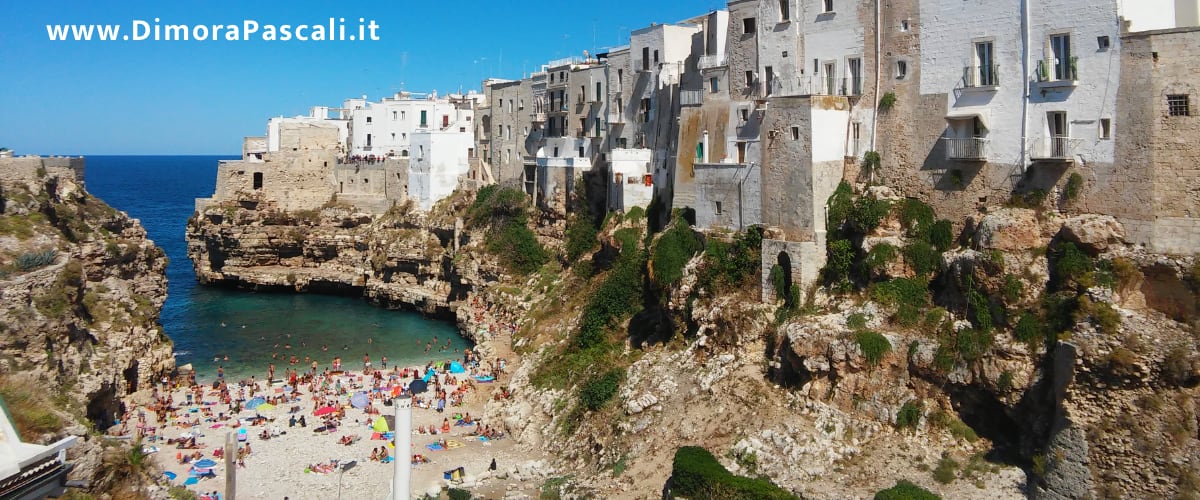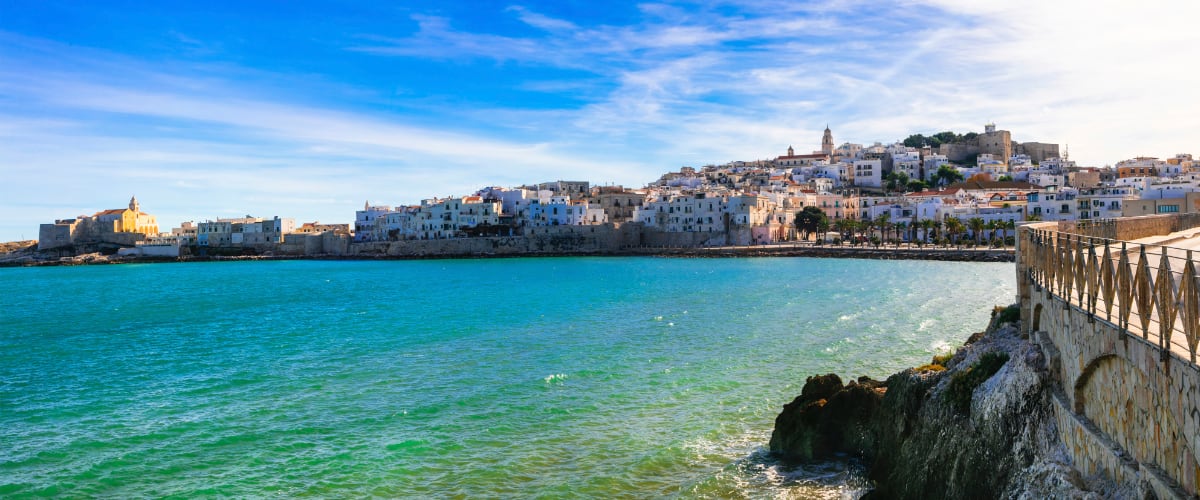Travel to Apulia

Dimora Pascali - Accommodation facility in Puglia - is among the accommodation facilities that accepts the Holiday Bonus.
Booking ->
Puglia, what to see what to do
Welcome to Apulia, middle land. In the past, a land of conquest. Man has left his mark here since prehistoric times. Today it is a land of hospitality, thanks to its wide range of tourist attractions that can satisfy every type of traveller. With its 800 km of coastline, it is the ideal place for a seaside holiday. With its countryside rich in history, culture and traditions, it appeals to those who love to discover their origins in natural and rural landscapes of ancient memory. Indeed, even the coasts offer special ways of reliving history, and the hinterland, dotted with vineyards and olive groves and therefore with reference agricultural products, offers the possibility of following unique food and wine routes.
Apulia is Italy's most eastern region. In its most easterly part, located towards Otranto, Punta Palascìa to be precise, you can admire the first sunrise in Italy.
The Apulian climate is mild all year round and allows for sunny summers in which the main attraction is the sea. Towards April-June and September-October the temperatures allow for long walks and bicycle rides. During this period, it is pleasant to pass through scenic places, historical sites and interesting villages on walks that can last for weeks at a time. Among the various examples of rural architecture, historic farms are the most predominant. These historic buildings have now often been converted into accommodation and agritourisms. Apulia is also adorned with UNESCO World Heritage monuments, such as the trulli of Alberobello.
Nature also leaves its mark in national parks such as Murge and Gargano, and marine reserves such as Tremiti Islands and Torre Guaceto. There are also countless protected areas.
Apulia is a vast territory. In this article we take an overview of this southern Italian region, describing it from north to south. A travel south to discover what to see and do in Apulia.
Gargano in Puglia
In the North of Apulia there is Gargano peninsula, which consists of the Gargano promontory, the only one in Apulia, the lakes of Lesina and Varano, countless cliffs and vast beaches of fine sand. Among the rocks, arches and caves on the sea can also be admired from the sea on a small boat.
In the central-eastern part of the Gargano we can find Gargano National Park, a protected nature reserve which, with its rich and ancient vegetation, fascinates nature-loving tourists and trekkers.
There are numerous points of interest to visit, including towns, rural landscapes, historical buildings and religious sites, we suggest a few: Manfredonia (where we find the Swabian-Angevin Castle that now houses the National Archaeological Museum), Mattinata, Zagare Bay, Pugnochiuso, Vieste, Peschici, Rodi Garganico, Margherita di Savoia (with its salt pans and pink flamingos), the Umbra Forest, Monte Sant'Angelo and the Sanctuary of San Pio da Pietralcina in San Giovanni Rotondo.
From Vieste, Peschici and Rodi Garganico it is possible to reach one of the most popular destinations for tourists: Tremiti Islands. They are full of landscapes and history that fascinate any tourist who visits them.

Tavogliere delle Puglie.
Next to the Gargano promontory it can found Tavoliere delle Puglie. A vast plain, the largest in Italy after the Po Valley.
Today, this area is intensely covered with olive trees, vineyards and, above all, cereals from which high quality foodstuffs are obtained, including DOP oils and fine DOC wines. Moreover, due to its vastness and wheat production, Tavoliere delle Puglie is considered the 'granary of Italy'.
Foggia, San Severo and Cerignola are the most important towns In this area.
Monti Dauni
Next to Tavoliere delle Puglie and at the antipodes of the Gargano Promontory we find the Monti Dauni chain.
Murge
Heading south, we enter the vast area of Murge, a limestone plateau that extends as far as the Salento Plain.
Trani e Giovanazzo
Beyond Margherita di Savoia, on the coast, one of the most characteristic towns to visit is certainly Trani, whose Basilica overlooking the sea attracts the attention of visitors with wonder. Like Trani, Giovinazzo also offers a characteristic historic centre overlooking the port, dominated by the Cathedral.

Bari
Further south, in the heart of Apulia, overlooking the sea, we can admire the Apulian county seat: Bari.
Bari's urban layout is in stark contrast between the old town and the modern city, the two one divided by Corso Vittorio Emanuele II.
The Apulian county seat was the main port of the Crusades between the 11th and 12th centuries.
Bari: What to see and where to go
Bari's main tourist attractions are: the Swabian Castle, the majestic Basilica in Apulian-Romanesque style dedicated to St Nicholas, the alleys of the old town crowded with typical shops and bakeries where you can buy typical Bari products such as focaccia, orecchiette and fresh fish.
There are three of the city's most important theatres: Teatro Margherita, now a museum, Teatro Piccinni and Teatro Petruzzelli, rebuilt after a fire in 1991.
Via Sparano is the most elegant street in Bari undoubtedly, probably the busiest in the city, which divides it in two, crossing it from Bari Station, located in Piazza Aldo Moro, to the historic centre.
Polignano a Mare
Slightly further south in Apulia, still on the beautiful coast, we find Polignano a Mare.
Polignano a Mare offers breathtaking views of the sea from the typical panoramic terraces. For this reason this location is elected among the best cities for the Red Bull Cliff Diving World Series of which you can find an interesting article in this blog of Dimora Pascali.
Polignano a Mare offers countless opportunities for the tourist traveller. Both for the countless attractions within the municipality (we will talk soon with a new article) and because Polignano is located in a strategic position in Apulia that allows you to visit it staying in one place and then without the burden of having to change accommodation.

Altamura and Gravina di Puglia
Towards the border with Basilicata there are two very interesting towns from a historical point of view: Altamura and Gravina di Puglia.
Altamura is famous for the most famous bread in the world: the typical bread of Altamura. Its cathedral dedicated to Santa Maria Assunta is also important.
Gravina di Puglia is seat of the Alta Murgia National Park. As the name suggests, the surrounding area is characterised by cracks in the earth's crust similar to canyons, the gravine.
It was Frederick II of Swabia who gave it this name. The emperor used to hunt in these areas before retiring to his octagonal manor at Castel Del Monte (now a UNESCO World Heritage Site).

Valle d’Itria
In Apulia, among the simplest and brightest places, Itria Valley stands out. Characterised by the Trulli of Alberobello (typical dry-stone cone-shaped buildings of the Apulian countryside dating back to the 17th century), small characteristic towns and a rich history, this area is immersed in nature.
Itria Valley includes the town of Cisternino, Locorotondo, Martina Franca and a little more.
There are many farms in the area which have been converted into holiday farms.
Torre Guaceto, nature reserve
Torre Guaceto is a marine protected area of habitat and species conservation dotted with steppes and dunes.
Egnazia archaeological excavations
Egnazia is of particular historical and cultural importance, it is a city of the past whose remains can be visited today. Greek and Roman civilisations followed one another here. The necropolis and the underground tunnels are of historical and architectural interest.
Lecce and its tipical baroque
Important and fascinating, Lecce's baroque style covers the city of Lecce which, precisely because of its architectural heritage, has often been called the Florence of the South.
The alleys of Lecce are lined with palaces, monuments and churches, one after the other in an almost constant succession. Basilica di Santa Croce, built between the 16th and 17th centuries, is typically baroque. Palazzo dei Celestini, dating from the 17th century, next to the basilica, now houses the Government Palace and the Provincial Administration.
Cathedral with its high bell tower, Bishop's Palace, Piazza Sant'Oronzo, Roman Amphitheatre, Palazzo del Sedile and Roman Theatre are absolutely worth visiting in Lecce.

Otranto, a fortified Apulian town
Characteristic is the pentagonal-shaped Aragonese Castle, which inspired Horace Walpole's Gothic novel “The Caste of Otranto”.
The Cathedral is very important as it houses the largest floor mosaic in Europe.
Gallipoli, city of young people
Overlooking the Ionian Sea, in recent years Gallipoli has attracted many young people who have flocked to this wonderful place thanks to the sea and the fun.
The historic centre of Gallipoli is particularly charming with its alleyways, now home to countless places to eat excellent fish.
Porto Cesareo and its sea
Porto Cesareo is important for its sea: golden beaches and enchanting sea form one of the largest marine protected areas in Italy.
Taranto coast
In Taranto, the MArTA National Archaeological Museum offers the opportunity to admire the famous "Ori di Taranto" (Taranto gold), refined productions of the local goldsmith's art dating back to between the 4th and 2nd centuries BC, as well as countless archaeological finds from all over Italy.
The revolving bridge inaugurated in 1887, which connects the old city to the new, is worth a visit.
Historical centres and ancient villages in Apulia
There are numerous historic centres to visit in Apulia, some of which are recognised as the most beautiful villages in Italy. These include Conversano with its Aragonese Castle and Romanesque cathedral, Martina Franca with the most beautiful balconies in Apulia, Specchia, a village of just 5,000 inhabitants, Cisternino, Locorotondo and Felline.
Apulian cuisine
In Apulia you can eat very well indeed. The abundance of agricultural products and other products from the land and sea allow the local cuisine to be enriched with unique dishes in terms of taste and wholesomeness.
Baked goods, meat, fish and numerous traditional products and dishes deserve to be described in more detail so that who wish to spend their holidays in Apulia can sample these delicacies.
Unmissable holiday offers in Apulia
Apulia offers countless reasons to visit. Finding a b&b as an accommodation in the middle of this region that allows you to visit it all easily is not difficult: Dimora Pascali is a valid alternative.
There are numerous offers Apulia that we propose for a stay designed for you. Dimora Pascali in Polignano a Mare will give you comfort and many unmissable advantages related to the structure and the place near the sea: rooms, parking, bikes, sea, beach, rocks, events, tradition.
At Dimora Pascali we are happy to provide you with any information you need to spend your holiday in Apulia in total safety and carefree.

